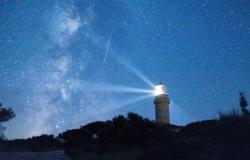NASA has released a series of images capturing what it says was a Korean spacecraft flying over the surface of the moon at thousands of kilometers per hour.
Interest in cosmological flight has piqued the interest of American politicians and the public over the past year, with new committees and groups trying to reveal what the US knows about flying objects that have been caught on camera.
With interest built up around Monday’s solar eclipse, the space agency has revealed that it managed to capture the moment that two spacecraft flew around the moon’s surface at the same time.
The Danuri orbiter is seen captured from a distance of 3.1 miles. This is one of a series of NASA images of a Korean orbiter passing over the surface of the moon.
NASA/GSFC/Arizona State University
From March 5 to 6, NASA’s Lunar Reconnaissance Orbiter (LRO), which has been circling the moon for 15 years, managed to capture images of the Korea Aerospace Research Institute’s Danuri lunar orbiter, traveling in a nearly parallel orbit.
The images, a series of black and white photos, showed what looked like a smeared line crossing over the moon’s surface. The LRO managed to capture the moment at a variety of distances 5 miles below the LRO’s orbit, between 5 to 2½ miles. The LRO’s orbit above the moon is around 31 miles, or 50 kilometers, according to NASA.
The LRO was launched in 2009 by NASA’s Goddard Space Flight Center to investigate the surface of Earth’s nearest neighbor and answer fundamental questions about its origin and evolution, along with our planet’s own.
These photos were captured by the LRO operations team at the Goddard Space Flight Center in Greenbelt, Maryland. Its narrow-angle camera, known as LROC, caught the moment during three orbits where it was close enough to record the Danuri orbiter. Even with a short exposure, the image showed the Korean aircraft as a smeared blur.
In this image, the Danuri lunar orbiter was close to NASA’s Lunar Reconnaissance Orbiter, about 2½ miles.
NASA/GSFC/Arizona State University
The LROC team said the two crafts’ relative velocity was around a stunning 3.2 kilometers per second, requiring “exquisite” timing to ensure the camera was pointed in the right direction at the right time.
In a post on it’s a fairly normal-looking orbiter. But the terrifying speeds involved mean that it’s smeared on the LRO’s camera detector.”
Byrne included a selection of the “unsmeared” images by NASA’s LRO team in an online thread.
The LRO was caught on film last spring by a Korean orbiter. It shot the NASA spacecraft flying above it at around 11 miles away on April 7, 2023.
ShadowCam, a NASA-funded instrument hosted on Danuri lunar probe, took the picture and was able to create a high-resolution simulation of the orbiter’s path, based on a similarly blurry image.

A high-resolution simulated view of NASA’s Lunar Reconnaissance Orbiter taken from ShadowCam.
NASA/KARI/ShadowCam
Uncommon Knowledge
Newsweek is committed to challenging conventional wisdom and finding connections in the search for common ground.
Newsweek is committed to challenging conventional wisdom and finding connections in the search for common ground.






